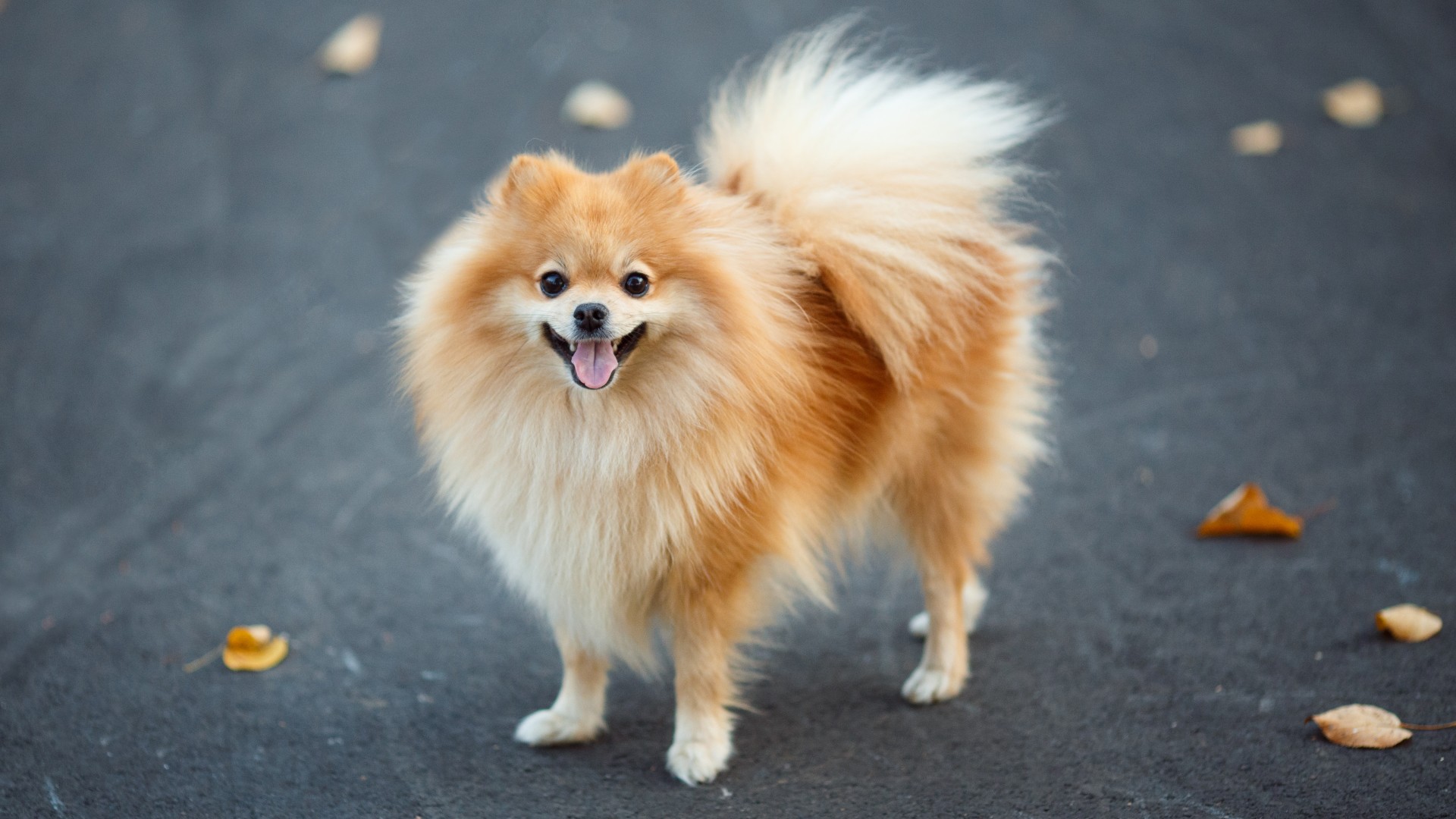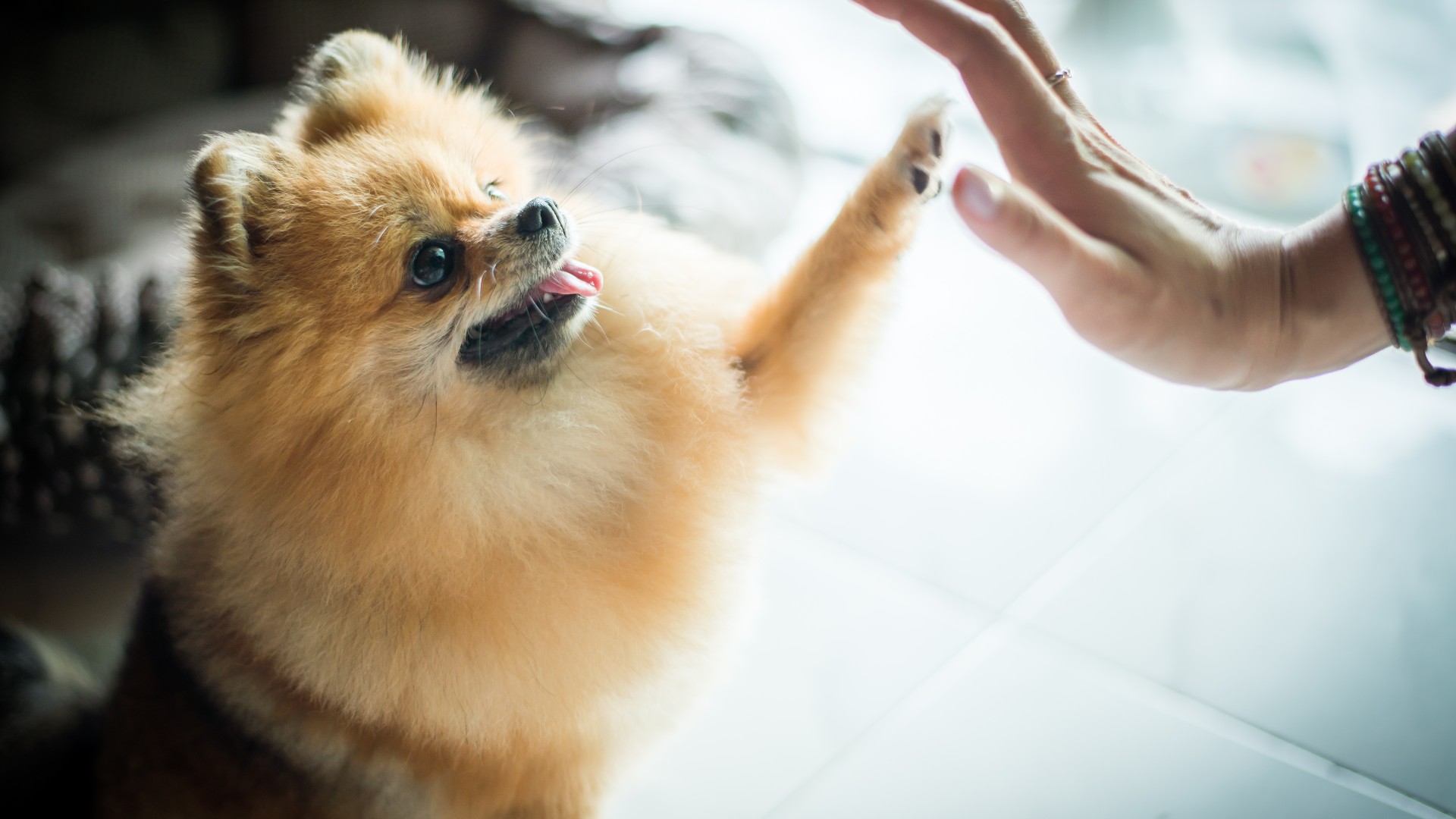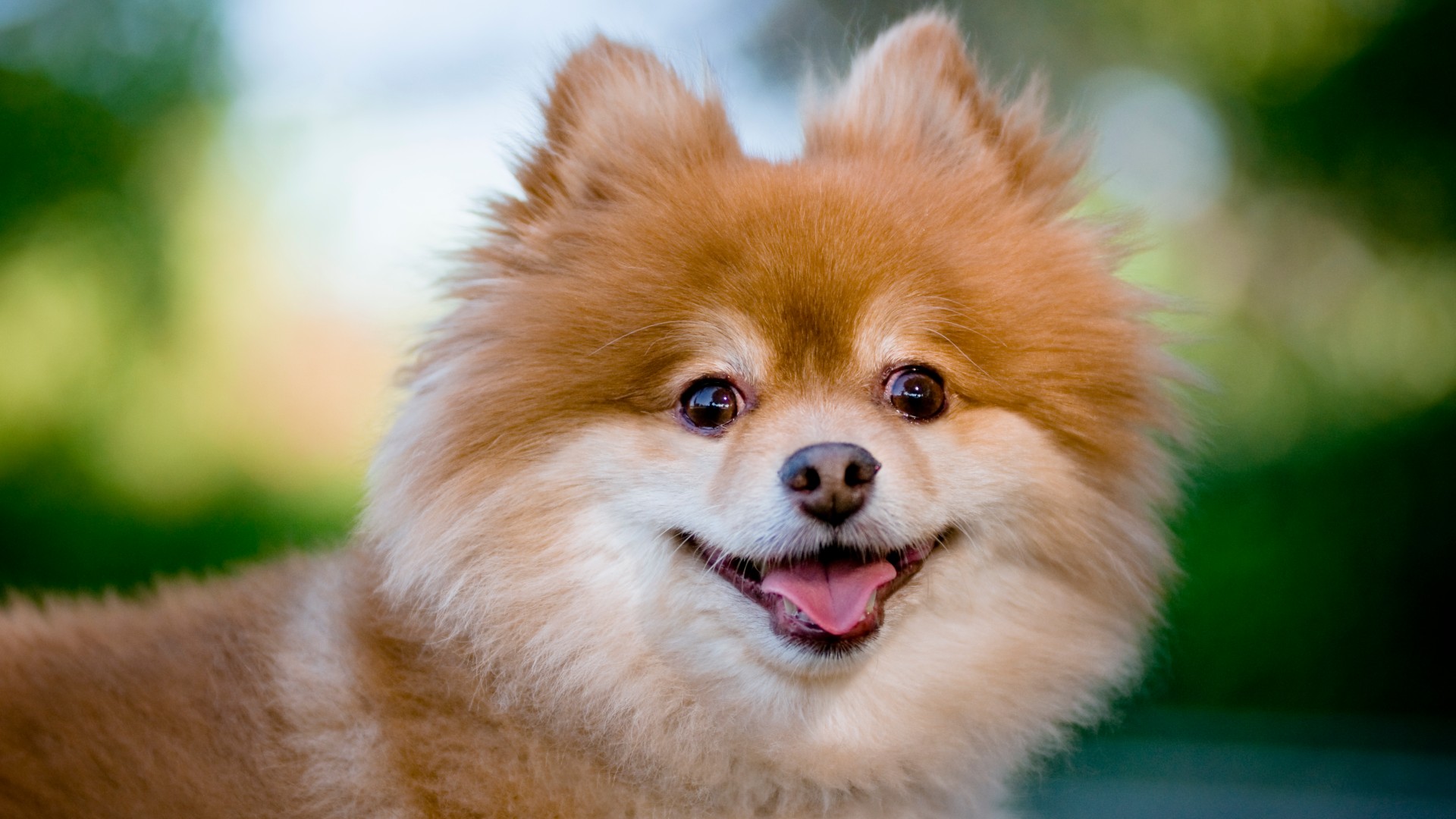Pomeranian dog: Breed profile
The perky and plucky Pomeranian dog has a spirited nature and an intelligent and inquisitive mind, but its bark may not be ideal for those in search of the quiet life

If there was an award for the happiest little dog in the world, we're pretty sure the Pomeranian would be a top contender! This perky, spirited ball of fluff is an absolute joy to have around, so it's no surprise that it was popular with the rather sour-faced Queen Victoria, who liked the smile they brought to her face so much that at one stage she had 35 of them!
The smallest of the Spitz family of dogs, Pomeranians hail from the Pomerania region in north-west Poland and north-east Germany and while their small size may make this hard to believe, they actually descend from large sled-dog breeds that worked in the Arctic.
While they may weigh a mere three to seven pounds, this teeny tiny dog has a personality the size of Canada with plenty of loyalty, fun, intelligence and feistiness coming packaged up in their pint-sized frame making them a wonderful addition to any family. As if that’s not brilliant enough, they are also one of the longest living dog breeds.
But the cute Pomeranian isn't without its drawbacks. You see, while to the outside world they are clearly a toy dog breed, to the Pom themselves they have the stature to rival an elephant and a heart the size of a lion, which means they're prone to biting off more than they can chew when it comes to taking on dogs that are many times their size.
That being said, with the proper socialization and training, the courageous Pomeranian can be taught not to pick on other dogs, which is just as well as otherwise you could spend the bulk of your daily walking time apologizing to other dogs for your independent and curious Pom's boldness!
Aside from that one drawback, the Pomeranian really is the most delightful dog and it's lively, inquisitive and affectionate nature, it will make a beautiful addition to your family. Let's take a closer look and see if the perky Pom is the dog for you...
How much exercise does a Pomeranian need?
Life expectancy: 12-16 years
Average weight: Male: 4.5 lbs/2kg
Female: 5.5lbs/ 2.5kg
About the same as: two liters of water
They may be small, but if you like your exercise you don't need to worry - this is one little dog who can more than keep up and will quite possibly end up putting you through your paces rather than the other way around! With bags of energy to burn, twice-daily walks will be a breeze for this breed, but just keep in mind that they are small so it's best to keep it to around 30 minutes per session.
Get the best advice, tips and top tech for your beloved Pets
You can also take them on long walks if you make sure they have plenty of water, a few of the best dog treats, and short breaks at regular intervals. It's important they don't overdo it, however, so watch them carefully during periods of hot weather because they can quickly overheat and suffer heatstroke.
It's really important that you keep your Pom on a lead whenever you're out walking - both for their benefit and the benefit of other dogs. That's because their small size makes them a prime target for being attacked by wild animals who will view them as prey and of course, as we know, the brave and plucky Pom will also try to square-up to larger dogs, so it's best to eliminate the temptation!
When at home, give your Pom plenty of the best dog toys to help them remain active and occupied throughout the day. As they get bored easily when exposed to any one thing for too long, make sure you have a variety of chew toys, fetch toys, and ball toys on hand to keep them engaged. Puzzle toys that release treats are also a great choice for this inquisitive breed.
How easy is it to train a Pomeranian?

Suitable for: People who live in small homes and want a perky, friendly, and spirited companion
Not suitable for: Those who enjoy the quiet life
Temperament: Playful, intelligent, energetic, friendly, stubborn
Shedding: Heavy
When it comes to training your little pocket rocket, you'll find that as long as you're firm and consistent (and start early!) the smart and eager to please Pom will have those commands and behavior expectations mastered in no time.
This really is a super intelligent dog and they actually love learning, so reward them with plenty of treats and praise as you go along and training them will be an absolute joy. Poms respond best to positive and patient training methods and they particularly like short and specific words and any kind of training that incorporates games and tricks.
Socialization is key with this breed as by now you've learned that they will not hesitate to bravely and fiercely charge head first into battle regardless of their short stature and the often mammoth size of their opponents. Training them to mix well with other dogs and people can help them grow into confident but appropriately cautious adults who will think before they act.
You should also take extra care and time to housetrain this breed because their stubborn nature can make the task (which can take as many as four months) a little more difficult. Consider crate training as part of this and educate young children that Poms are not toys, even though they look tiny. Rough handling of these dogs can cause them injury.
What do Pomeranians eat?
The younger your Pomeranian, the more often they should eat, but this changes once they reach adulthood. As adults, they need a quarter to half a cup of quality dry dog food twice a day with limited free grazing to prevent obesity.
We recommend opting for a kibble that’s been designed for small indoor dogs as these are nutritionally balanced, highly digestible, and encourage chewing. Human food scraps should be avoided as Pomeranians can be fussy eaters and giving them a taste for an alternative food may prove counterproductive to your efforts to feed them in the future.
Pomeranian temperament
Vivacious, fun-loving and energetic, the extroverted Pom loves being the center of attention and their inquisitive nature means they love meeting new people and accompanying you on adventures. What they don't seem to have any understanding of, however, is just how small and fragile they are, so they really do need their pet parent to look out for them.
Perky and friendly, the Pom is also highly alert and that coupled with their endless curiosity and being one of the loudest dog breeds, they make excellent watchdogs. They will need training around the barking though as otherwise it can become excessive and more of a hinderance than a help!
Much like the pug, the Pom is a natural comedian who adores making their humans laugh by performing tricks and just generally goofing around, so they make the perfect furry family friend for those in search of a spirited companion and children in particular will adore them.
Do Pomeranians shed a lot?

You may look at a Pomeranian and think: “Wow, so much bushy hair. That's going to be a pain to keep on top of, isn't it?” Well, boy oh boy do we have good news for you because it's actually not.
While it's true that Poms are heavy shedders at particular times, males only shed their fluffy undercoat once per year and non-neutered females twice a year, so when you couple that with their small size, the amount of fur flying around for you to clean up won't be anywhere near as bad as you'd expect.
We recommend you do brush your Pom twice a week though as this will ensure their coat stays free from knots and tangles. It will also help to distribute the natural oils which will bring a brilliant shine to their glorious coat.
You’ll also want to clip their nails regularly and brush their teeth several times a week and the odd bath here and there will help keep them looking fresh and smelling sweet. But aside from that Poms are a lot more low maintenance than first glances would have them appear.
Wisdom Panel Breed Discovery DNA Kit | Amazon
Not sure exactly what breed your dog is? This kit screens for 365+ breeds – because knowing every detail about your dog helps you understand how best to care for them.
Pomeranians health problems
Amount Of Shedding: High
Easy To Groom: Yes
General Health: Good
Potential For Weight Gain: High
On the whole the perky and spirited Pom is generally a healthy and long-living little dog, but there are still some potential big issues that you really need to be aware of. First up, tracheal collapse, a progressive weakening of the windpipe cartilage is quite common in Poms because of their small size, which makes the cartilage more prone to injury.
They also have a very small mouth in relation to the size of their teeth, which can cause overcrowding as well as food getting trapped in the teeth leading to plaque and tartar buildup as well as the gum disease, gingivitis. Regular teeth cleaning is really important for this breed to ensure good oral health and hygiene.
This breed can also suffer from luxating patella where the kneecap slips out of its groove, as well as a thinning of the coat as they get olde, and canine cataracts affecting their sight. However, with good exercise, regular vet check-ups, and a good diet to prevent them from becoming obese, you'll find that Pomeranians suffer little illness throughout their life.
Should I get a Pomeranian?

The Pom is one of those breeds that is just an utter joy to be around. We mean, what's not to like? They're curious, intelligent, affectionate, funny, playful, loving and have a spirited and feisty nature you just can't help but fall in love with. They're also fairly low-maintenance and easy to care for.
Yes, they can be hugely independent and stubborn at times, which means patience and consistency will be key across all areas of training if you want to avoid feeling frustrated by this little dog with the big personality. And you do need to keep a watchful eye on them as their small size makes them prone to being injured if they're not handled correctly by others.
But, for any pet parent who is willing to bear those potential issues in mind and doesn’t mind taking them on, the extroverted Pomeranian will quickly show themselves to be a vivacious and loyal companion whose endless antics will never fail to make you laugh.
Want to know more about this breed? Here are our favorite Pomeranian facts. Or, read our profile on Chihuahuas vs Pomeranians.

David Crookes has been a journalist for almost 30 years and he has written for a host of magazines, newspapers, websites and books including the World of Animals Annual, BBC Earth, Live Science, The Independent and Tom’s Guide.
Born in England, he lives with two cats but he’s also keenly interested in the differences between the huge number of dog breeds – in fact, you can read many of his breed guides that he’s written in collaboration with vets here on PetsRadar.
With a lifelong passion for technology, too, he’s always on the lookout for useful devices that will allow people to keep their pets happier and healthier, and provide them more time to spend together.
David has a degree from Durham University, as well as postgraduate diploma in journalism from the University of Central Lancashire.

